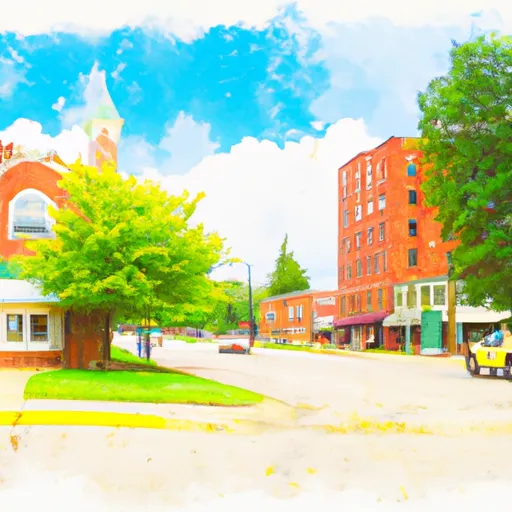-
 Snoflo Premium
Snoflo Premium
Get unlimited access to all our content
With no Ad interruptions! - Start Your Free Trial Login with existing account
Marion
Eden Index
Climate
6.4
•
Recreation
1.8
•
Community
1.3
•
Safeguard
3.5/10

Marion, Michigan is a small town located in Osceola County. It experiences a humid continental climate with four distinct seasons. Summers are warm, with average temperatures ranging from 70°F to 80°F (21°C to 27°C), while winters are cold, with temperatures ranging from 20°F to 30°F (-6°C to -1°C). Annual precipitation in Marion is around 36 inches, evenly distributed throughout the year, and snowfall is common during the winter months.
The town is surrounded by abundant natural beauty, with several lakes and rivers in the area. The Muskegon River flows nearby, offering opportunities for fishing, kayaking, and canoeing. The river is known for its diverse species of fish, including trout, salmon, and steelhead.
Additionally, Marion is in close proximity to the Pere Marquette State Forest, which provides excellent opportunities for hiking, camping, and wildlife viewing. The forest is home to various species, including white-tailed deer, wild turkeys, and small game.
In conclusion, Marion, Michigan offers a pleasant climate with distinct seasons, ample hydrology constituents in the form of lakes and the Muskegon River, and abundant outdoor recreation opportunities in the surrounding Pere Marquette State Forest.
What is the Eden Index?
The Snoflo Eden Index serves as a comprehensive rating system for regions, evaluating their desirability through a holistic assessment of climate health, outdoor recreation opportunities, and natural disaster risk, acknowledging the profound impact of these factors on livability and well-being.
Climate Health Indicator (CHI): 6.4
Marion receives approximately
826mm of rain per year,
with humidity levels near 84%
and air temperatures averaging around
7°C.
Marion has a plant hardyness factor of
5, meaning
plants and agriculture in this region thrive during a short period during spring and early summer. Most
plants will die off during the colder winter months.
By considering the ideal temperature range, reliable water supplies, clean air, and stable seasonal rain or snowpacks, the Climate Health Indicator (CHI) underscores the significance of a healthy climate as the foundation for quality living.
A healthy climate is paramount for ensuring a high quality of life and livability in a region, fostering both physical well-being and environmental harmony. This can be characterized by ideal temperatures, reliable access to water supplies, clean air, and consistent seasonal rain or snowpacks.
Weather Forecast
Streamflow Conditions
Northeastern Lake Michigan
Area Rivers
Northeastern Lake Michigan
Snowpack Depths
Northeastern Lake Michigan
Reservoir Storage Capacity
Northeastern Lake Michigan
Groundwater Levels
Recreational Opportunity Index (ROI): 1.8
The Recreational Opportunity Index (ROI) recognizes the value of outdoor recreational options, such as parks, hiking trails, camping sites, and fishing spots, while acknowledging that climate plays a pivotal role in ensuring the comfort and consistency of these experiences.
Access to outdoor recreational opportunities, encompassing activities such as parks, hiking, camping, and fishing, is crucial for overall well-being, and the climate plays a pivotal role in enabling and enhancing these experiences, ensuring that individuals can engage in nature-based activities comfortably and consistently.
Camping Areas
| Campground | Campsites | Reservations | Toilets | Showers | Elevation |
|---|---|---|---|---|---|
| Tahquamenon Falls 2 State Park | 90 | 752 ft | |||
| Tahquamenon Falls 1 State Park | 275 | 616 ft | |||
| Lake Michigan | 34 | 601 ft | |||
| Garnet Lake - State Forest | 10 | 842 ft | |||
| Brevort Lake | 84 | 632 ft | |||
| Three Lakes | 28 | 877 ft | |||
| Hog Island Point - State Forest | 59 | 587 ft | |||
| Epoufette Township Park | 5 | 588 ft | |||
| Trout Lake City Park | 83 | 830 ft | |||
| Little Brevoort Lake (South) - State Forest | 12 | 651 ft |
Nearby Ski Areas
Catastrophe Safeguard Index (CSI):
The Catastrophe Safeguard Index (CSI) recognizes that natural disaster risk, encompassing floods, fires, hurricanes, and tornadoes, can drastically affect safety and the overall appeal of an area.
The level of natural disaster risk in a region significantly affects safety and the overall livability, with climate change amplifying these risks by potentially increasing the frequency and intensity of events like floods, fires, hurricanes, and tornadoes, thereby posing substantial challenges to community resilience and well-being.
Community Resilience Indicator (CRI): 1.3
The Community Resilience Indicator (CRI) recognizes that education, healthcare, and socioeconomics are crucial to the well-being of a region. The CRI acknowledges the profound impact of these elements on residents' overall quality of life. By evaluating educational resources, healthcare accessibility, and economic inclusivity, the index captures the essential aspects that contribute to a thriving community, fostering resident satisfaction, equity, and social cohesion.

